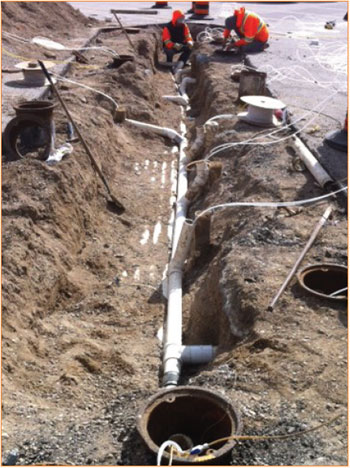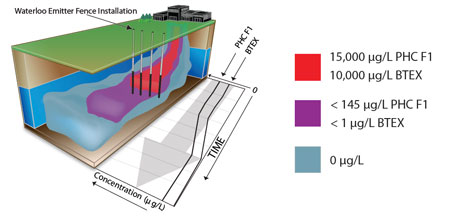An aquifer in Central Ontario became contaminated with BTEX and PCH F1 (Petroleum Hydrocarbons – Fraction #1i) from leaking underground infrastructure linked to a gas station. The groundwater in the aquifer flows between 3 -13 meters a year, as such, a voluntary cleanup of the aquifer was initiated to remediate the plume source, and to stop the dissolved plume phase from moving off-site.
The unconfined aquifer consists of fine sand, with the water table approximately 16 meters below ground surface. The contaminant plume extends approximately from the water table to 2 -3 meters below, and is about 40 meters wide.

It is a commercial site, so the client needed a solution that was not highly visible and had minimal site disturbance, or disruption to normal site activities. Because the dissolved plume is located deep within the subsurface, and after initial geochemical testing showed that the plume was oxygen-limited, the Solinst Waterloo Emitter was chosen as the primary remedial device for the dissolved phase plume.
In the summer of 2009, 58 Waterloo Emitters were installed in 29 wells. Two Emitters were installed in each well. The wells were spaced 1.5 meters apart, and positioned as a fence down gradient from the source, perpendicular to groundwater flow.
The Water Emitters were installed in 4″ PVC wells that had screens across and below the water table, with allowances for seasonal fluctuations. 3.8″ diameter Waterloo Emitters were used, some with LDPE tubing, while in the higher flux areas of the plume, more diffusive silicon tubing was used. Oxygen is supplied to the Emitters using cylinders stored in a secured shed at surface.

Groundwater flowing to the Emitter fence has much higher concentrations of BTEX and PHC F1 compared to the treated groundwater flowing down gradient from the fence.
The results have been “extremely good”, according to Rick McGregor of InSitu Remediation Services Ltd. The system was originally designed to treat Petroleum Hydrocarbon concentrations of about
5,000 μg/L, yet the system has effectively treated 3 times that. In addition, maintenance has been kept to a minimum, and iron precipitation found on the Emitters has not affected their function.
Independent consultants have been monitoring the performance of the Emitters on a quarterly schedule. They collect samples of groundwater down and up gradient, which are analyzed for a variety of inorganic and organic parameters.
Initial Dissolved Oxygen (DO) concentrations were below 1 mg/L. After the Emitters were installed, DO levels increased to more than 12 mg/L, with no changes in concentration over time. Groundwater flowing to the Emitter fence has concentrations of greater than 10,000 μg/L of BTEX and approximately 15,000 μg/L of PHC F1. The treated groundwater down gradient of the fence, has concentrations of less than 1 μg/L BTEX and less than 145 μg/L PHC F1.
The client and InSitu Remediation Services have been very pleased with the results: “The Emitters have provided a cost-effective and robust method for delivering oxygen to the PHC plume while minimizing [operation and maintenance] costs. The system continues to be as effective 3 years after installation as it was on Day 1 with no increase in costs”.
i“Fraction” refers to the equivalent normal straight-chain hydrocarbon (nC) boiling point ranges (Fraction #1: nC6 to nC10) according to the CCME, 2008.
Solinst thanks Rick McGregor, of InSitu Remediation Services Ltd, for providing the details of this project.
